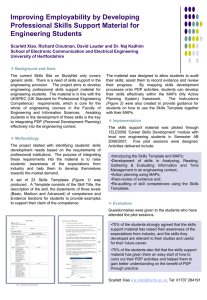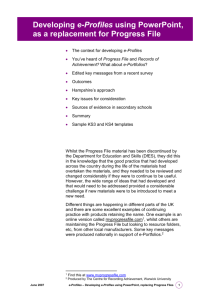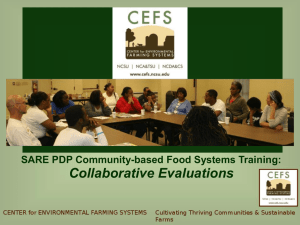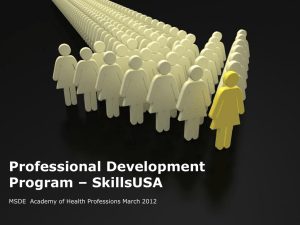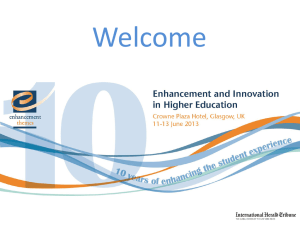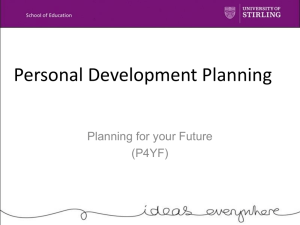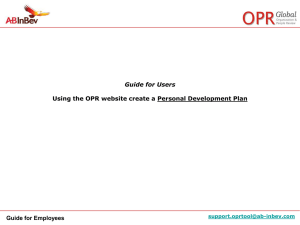Hampshire personal development learning and e
advertisement
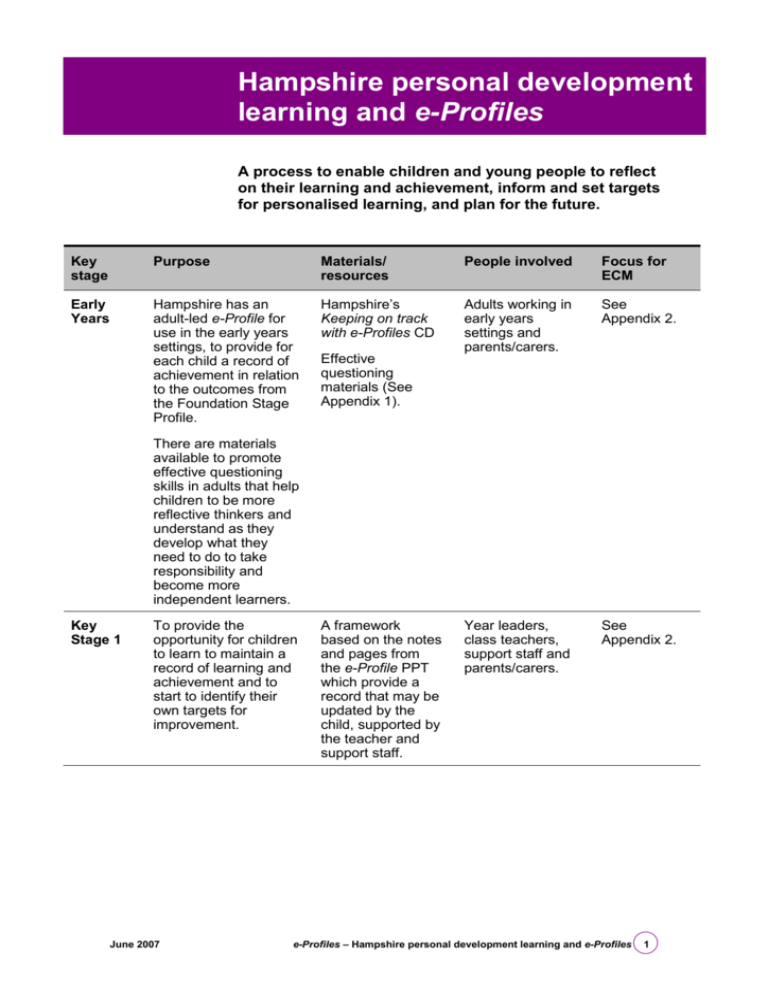
Hampshire personal development learning and e-Profiles A process to enable children and young people to reflect on their learning and achievement, inform and set targets for personalised learning, and plan for the future. Key stage Purpose Materials/ resources People involved Focus for ECM Early Years Hampshire has an adult-led e-Profile for use in the early years settings, to provide for each child a record of achievement in relation to the outcomes from the Foundation Stage Profile. Hampshire’s Keeping on track with e-Profiles CD Adults working in early years settings and parents/carers. See Appendix 2. Year leaders, class teachers, support staff and parents/carers. See Appendix 2. Effective questioning materials (See Appendix 1). There are materials available to promote effective questioning skills in adults that help children to be more reflective thinkers and understand as they develop what they need to do to take responsibility and become more independent learners. Key Stage 1 To provide the opportunity for children to learn to maintain a record of learning and achievement and to start to identify their own targets for improvement. June 2007 A framework based on the notes and pages from the e-Profile PPT which provide a record that may be updated by the child, supported by the teacher and support staff. e-Profiles – Hampshire personal development learning and e-Profiles 1 Key stage Purpose Materials/ resources People involved Focus for ECM Key Stage 2 To provide the basis in Year 6 to support children in preparing for, and making transition into, secondary school. A framework based on the notes and pages from the e-Profile PPT that enables children to both maintain a record that translates into a presentation about their hopes and ambitions during Year 7 and reflects their current level of achievement. Year 6 team leaders and teachers, the Year 7 team leader from the secondary school and parents/ carers. See Appendix 2. Key Stage 3 To provide students with the knowledge, skills and understanding to make curriculum choices at the end of KS3 that reflect their potential, in terms of ability and interests, and enable them to keep as many options open as possible for any career choices they may have in mind. A framework based on the notes and pages from the e-Profile PPT that enables students to develop an Individual learning plan to both support curriculum choices and to set the agenda of learning targets for the start of Year 10. KS3 pastoral/ curriculum leader, tutor, learning mentor and parents/carers. See Appendix 2, 3 and 5. The Connexions PA may also have an involvement during the key stage. The QCA’s Personal, learning and thinking skills (PLTS) framework (see Appendix 3). Key Stage 4 To provide students with the knowledge, skills and understanding to demonstrate their achievements during KS4 which reflects their potential, in terms of ability and interests, to support their transition into Post-16 learning or work. A framework based on the notes and pages from the e-Profile PPT that enables students to develop an individual learning plan to both set targets in preparation for GCSE and support transition Post-16 to learning or work. KS4 pastoral/ curriculum leader, tutor, learning mentor and parents/carers. See Appendix 2, 3 and 5. The Connexions PA may also have an involvement during the key stage. The QCA’s PLTS framework (see Appendix 3). 2 e-Profiles – Hampshire personal development learning and e-Profiles June 2007 Key stage Purpose Materials/ resources People involved Focus for ECM Post-16 To provide the basis for students to continue to maintain their personal plan and support transition to higher education (HE) or employment. A framework that collects the necessary information to enable students to complete their UCAS application and/or develop an up-to-date CV to accompany an application to an employer. UCAS tutor. See Appendix 2 and 3. 14 – 19 To provide a coherent approach, across institutions, for reflection, recording achievement and action planning, where students are learning in different locations in KS4 and transferring to a Post-16 college to continue their learning programme at 16. A framework based on the notes and pages from the e-Profile PPT that enables young people to both maintain a record that translates into a presentation about their hopes and ambitions for their future and reflects their current level of achievement. 14-19 learning mentor. See Appendix 2, 3, 4 and 5. June 2007 e-Profiles – Hampshire personal development learning and e-Profiles 3 Key stage Purpose Materials/ resources People involved Focus for ECM SEN settings To provide an appropriate and relevant framework to match the learning disabilities of young people with special learning needs that recognises achievement, celebrates success and sets out the young person’s wishes for what happens at transition. A framework based on the notes and pages from the e-Profile PPT that enables young people to both maintain a record that translates into a presentation about their hopes and ambitions for their future and reflects their current level of achievement. Tutor responsible for transition planning. See Appendix 2, 3 and 4. This links to the statutory requirements for a transition plan informed by the views of the young person. (See Appendix 4 – principles for involving young people in their transition planning.) Note: This model is intended to build on current good practice in Hampshire schools/ colleges, where pupils/students are provided with the opportunity to maintain a record of achievement and progress in learning and to plan for improving their performance by setting and achieving appropriate and relevant targets in relation to their ability and aspirations. A quality review framework is offered to allow schools and colleges to undertake a self-evaluation of the process they have in place to support this. See Appendix 5. 4 e-Profiles – Hampshire personal development learning and e-Profiles June 2007 Appendix 1 Using skilful questioning to improve children’s learning in the early years “The voices of very young children are not always heard ... either because they have not been asked to speak or we have not known how to ask them. With older children with welldeveloped language skills we can more easily talk to them and establish their views. It is far more challenging to include children under five who may still lack the words and experiences to express their views and preferences about their education. Children at the Foundation Stage of learning are well able to share what their learning targets are and can have a definite view on how to go about these.” 1 Adults working in early education settings need to: ask questions that help children develop review skills to identify what needs to be improved organise the way that children work, in order to provide opportunities for them to reflect on their learning help children develop relevant vocabulary and use interesting words about assessment and reviewing progress create references to thoughts and feelings about how they are performing. Improving questioning The acid test of a question is: Does it provide a worthwhile challenge? In providing a challenge, there needs to be a balance between closed quick-fix questions, and open questions that demand more complex and higher-order thinking. The level of challenge will differ with the developmental stage the child has reached, reflected in the teacher’s assessment of the Foundation Stage Profile. Examples of open-ended questions that genuinely invite children to think include: “What do you think ...?” “How do you know ...?” 1 Hearing children’s voices in the early years, Hannah Mortimer (written for Support for learning, Vol: 19, Issue: 4, 2004) June 2007 e-Profiles – Hampshire personal development learning and e-Profiles 5 “Why do you think that ...?” “Do you have a reason ...?” “How can you be sure ...?” “Is this always so ...?” “Is there another way/reason/idea ...?” “What if ...?” “What if ... does not ...?” “Where is there another example of this?” “What do you think happens next?” Different children need different sorts of alternatives. Often the adult taking the puzzled listener role will be effective if he/she reflects genuine interest and attention to the child’s answer. Strategies to support thinking and talking include pause, prompt and praise. Helping children ask questions If children themselves identify what they want to know, then when they ask a question they are much more likely to value and remember the answer. Some questions will not be easy to answer. Display children’s questions and come back to them. They can be sorted into categories, for example: questions we can answer questions we can find the answer to questions that cannot be answered questions that will help our learning. Discuss with children the nature of good questions. Ask which of a list of questions is the best, or most interesting question. Find out what questions they would most like to have answered. Some alternative strategies that can prove more effective than questions in stimulating thoughtful discussion are given in the Table on the next page. Use alternatives to routine questions about the quality of work and the standard achieved, that actively encourages thinking and dialogue. 6 e-Profiles – Hampshire personal development learning and e-Profiles June 2007 Adult lead Starter examples: Withholding judgement Respond in a non-evaluative fashion. Ask others to respond. “Say more about ...” “There is no one right answer.” “What are the alternatives?” “Who has got a different point of view?” “Give reasons why …” Making a challenging statement “Supposing someone said ...” Contributing your own thoughts or experience “I think that ...” “Remember when ...” Allow thinking time. Discuss with a partner, then in a group. Pair children so they can discuss in their first language. Allowing rehearsal of responses “Try out the answer in your head.” “Try out the answer on your partner.” Inviting children’s questions “Would anyone like to ask Pat a question about that?” Using thinking aloud Model rhetorical questions. “I do not quite understand.” Asking a child to invite a response “Ali, will you ask someone else what they think?” Not asking for a show of hands Expect everyone to respond. Inviting children to elaborate Cueing alternative responses Challenging children to provide reasons Using think – pair – share June 2007 e-Profiles – Hampshire personal development learning and e-Profiles 7 Activities to encourage children’s questioning Activity Details Topic/review questions Children individually or in groups ask questions about criteria for assessing work that will help an individual reflect on their learning and consider how it may be improved. Hot-seating Children take turns to choose to be in the hot-seat to talk about their work. The other children create questions to ask the child in the hot-seat. Questions game One child chooses a piece of work. The other children have 20 questions to find out what it is about the work that the person values and feels is good. Only “Yes” and “No” answers are allowed. Only three direct guesses are allowed. Play in groups of six (eg: two choose, four ask). Interview questions Decide on someone to interview about their work. Children devise, share and evaluate the best interview questions. Keep a questions box, board or book Collect any interesting or puzzling questions that arise in the classroom about what makes a piece of work good. Create a place to write, store or display your questions, such as in a box, on a board or in a book. Set aside some time, such as at the end of the week, to choose and discuss a question. Metacognitive questions to assess learning Display some metacognitive questions to encourage children to assess and reflect on their own learning, such as “What have I learned?”, “What have I found hard?”, “What do I need to learn next?”, “What would help me do better?”. Discuss these in a plenary session. Older children could be helped to record their responses in a learning log that sits alongside the Record of Achievement. This might include examples of work, photographs of an activity, or a teacher note recording the child’s thinking where writing skills are limited. (There is good illustrative material of what this would be like in practice, shown in the HIAS video produced in Spring 2005 for the review of Creative development.) 8 e-Profiles – Hampshire personal development learning and e-Profiles June 2007 Appendix 2 The contribution of e-Profiling and person centred planning to achieving the five outcomes of Every child matters The outcomes of the Every child matters (ECM) agenda are being realised through the establishment of Children’s Trusts. This has introduced a coherent approach to children’s services and the need to meet the five outcomes for children. It is important in achieving this strategic overview that the role of children and young people is recognised in terms of their understanding and their responsibility in becoming successful and independent members of society as envisaged by the five outcomes. “If the people who are supposed to be the beneficiaries of change do not know that it is happening – then it probably is not happening …” Lord Herman Ousley e-Profiling and person centred planning provide the basis for raising awareness with young people of the personal skills, knowledge and understanding that are required for them to take responsibility for themselves and achieve satisfactory outcomes under each of the five headings. It also provides a format that encourages them to record their progress and achievements, recognise their goals and plan for future activity as part of the process. June 2007 Be healthy – e-Profiling contributes to a young person’s ability to review and assess their decision making and goal setting in relation to health issues and adult working life. Stay safe – e-Profiling offers opportunities for the young person to reflect on risk and behaviour, both for themselves and for others, in relation to learning and the world of work through recording their experiences and achievements in lessons, at work experience, and on work-related learning and enterprise activities. Enjoy and achieve – e-Profiling provides a strategy that allows the young person to set targets for work and leisure and understand the importance of a work/life balance. Make a positive contribution – e-Profiling challenges young people to plan for and record their involvement in voluntary community activities in their role as active citizens, set against the need to be productive wage e-Profiles – Hampshire personal development learning and e-Profiles 9 earning members of society. An example is planning for a gap year activity that offers support to those in challenging circumstances both at home and abroad. Achieve economic well-being – e-Profiling provides the facility to develop financial capability and plan for transition into further learning, training or employment, and may be used to challenge aspirations that ensure each young person is able to realise their potential as effective participants in future learning and work. “The success of participation activity must be measured by the changes that have resulted on specific issues and concerns raised by children and young people.” Lord Herman Ousley Supporting transitions The text below on supporting transitions is taken from the Common Core of Skills and Knowledge for the Children's Workforce. “Children and young people naturally pass through a number of stages as they grow and develop. Often, they will also be expected to cope with changes such as movement from primary to secondary school and for children with disabilities or chronic ill health, from children's to adult services. Such changes are commonly referred to as transitions. Some children may have to face very particular and personal transitions not necessarily shared or understood by all their peers. These include: family illness or the death of a close relative; divorce and family breakup; issues related to sexuality; adoption; the process of asylum; disability; parental mental health; and the consequences of crime. (…) It is important to understand a child or young person in the context of their life, to recognise and understand the impact of any transitions they may be going through. It is also vital to recognise the role of parents/carers in supporting children at points of transition and to understand the need for reassurance, advice and support that parents/carers and carers may express at these points.” Both e-Profiling and person centred planning provide a framework of activities and a common vocabulary that may be used by the range of individuals and organisations supporting young people in transition. The materials help to engage children and young people to take responsibility for their learning, work and lifestyle choices. 10 e-Profiles – Hampshire personal development learning and e-Profiles June 2007 Identifying transitions and providing the opportunity for those involved in helping young people to: listen to concerns, recognise and take account of signs of change in attitudes and behaviour build open and honest relationships using language appropriate to the development of the child or young person and the family culture and background manage the process of transition in a timely way and help the child or young person reach a positive outcome. Providing a framework of support through the effective use of e-Profiling in order to: June 2007 empathise by communicating simple, reassuring messages about key transitions reassure children, young people and those caring for them by explaining what is happening, and by exploring and examining possible actions to deal with new and challenging situations identify opportunities to discuss the effects and results of transition act to ensure that information transfers ahead of the child or young person, when appropriate, and respect other professionals when sharing information provide information relating to the facts surrounding the transition where appropriate, illustrate the benefits of transition make effective links with other practitioners should further support be necessary operate effective cross-agency referral processes. e-Profiles – Hampshire personal development learning and e-Profiles 11 Understanding how children and young people respond to change and to: consider issues of identity, delayed effects of change and be aware of possible signs that someone is going through a particular transition know about the likely impact of key transitions, such as divorce, bereavement, family break-up, puberty, the move from primary to secondary school, unemployment, and leaving home or care understand patterns of transition from childhood to adulthood, and appreciate that it may be different from your own or past experiences understand that children and young people with disabilities or special educational needs may need additional support to manage transitions, and know when to seek specialist advice know that children and young people can be influenced by peer group behaviour and that this may vary according to culture. 12 e-Profiles – Hampshire personal development learning and e-Profiles June 2007 Appendix 3 A framework of personal, learning and thinking skills 11 – 19 in England The framework comprises six groups of skills that, together with the functional skills of English, mathematics and ICT, are essential to success in learning, life and work. In essence, the framework captures the essential skills of: managing self, managing relationships with others and managing own learning, performance and work. It is these skills that will enable young people to enter work and adult life confident and capable. The titles of the six groups of skills are set out below. Team workers Self-managers Independent enquirers Creative thinkers Reflective learners Effective participators For each group there is a focus statement that sums up the range of skills. This is followed by a set of outcome statements that are indicative of the skills, behaviour and personal qualities associated with each group. Each group is distinctive and coherent. The groups are also inter-connected. Young people are likely to encounter skills from several groups in any one learning experience. For example, an independent enquirer would set goals for their research with clear success criteria (reflective learner and organise and manage their time and resources effectively to achieve these (self-manager). In order to acquire and develop fundamental concepts such as organising oneself, managing change, taking responsibility and perseverance, learners will need to apply skills from all six groups in a wide range of learning contexts 11 – 19. Further information and details of each group are available on the QCA website to be found at: www.qca.org.uk/17453.html . June 2007 e-Profiles – Hampshire personal development learning and e-Profiles 13 14 e-Profiles – Hampshire personal development learning and e-Profiles June 2007 Appendix 4 Severe learning disabilities students – principles of involvement in planning for transition Introduction With the advent of the Children’s Trust and the expectations for agencies that traditionally have been separate to work as one organisation, there are aspects of practice that need to be reviewed. One such area is the way that support is provided for young people with severe learning disabilities in transition from school/college (Children’s Services) towards adult life (Adult Services) in their community and services/funding that they may be able to access, including the involvement they have to influence what happens to them and have their views considered as part of the decision-making process. Transition at Post-16 is a time of choices, dealing with what will happen after school, where to live, what social life might be possible and the chances for work or continuing training. During this period, young people try new things and it is a time when they gain new rights and responsibilities. This time of transition can be an exciting time with new opportunities. It can also be a worrying time when young people move on from familiar people and places into the unknown. Guidance for schools in Section 10 of the DfES SEN Toolkit recommends that the young person’s views are taken into account during this process. But often not enough attention is given to young people and their involvement in decisions about their future. For these young people to be supported properly during transition, it is important that there is clarity about their own and other people’s roles to ensure a successful transition. The principles set out on the next page offer the opportunity for those in supporting roles to recognise the young person’s contribution to the transition process and incorporate them into their practice. June 2007 e-Profiles – Hampshire personal development learning and e-Profiles 15 Principles of involvement in planning for transition As a young person with learning disabilities, I have the right to a fulfilling life that takes account of my aspirations and abilities, and an involvement in the decisions that shape my future. In order for me to achieve my potential, those working with me should recognise: it is important for me to be included in society and not marginalised because of my disabilities the importance for me to be as independent as possible, with opportunities to develop the skills and relationships that will help me contribute to society I have the right for my views to inform all discussions about my future and to expect the action points to happen within the agreed time frame my views need to be collected over a period of time through a focused programme of personal development learning as they are my contribution to identifying the choices available to me and decisions about my future. Developing the young person’s involvement The principles outlined above provide ideas about the young person’s involvement in planning and achieving an effective and realistic transition. Schools, colleges and other agencies will need to consider ways to support young people and develop their ability to contribute to the process. There are solutions available to develop this strategy and schools and colleges have either devised their own materials or have drawn on two national products that support person centered planning: Transition Pathway materials Progress File. Within Hampshire, schools and colleges have tended to develop their own materials to support transition, whilst Adult Services use person centred planning to maintain the ongoing recording and action planning. 16 e-Profiles – Hampshire personal development learning and e-Profiles June 2007 The benefits of materials that have been devised by individual schools and colleges to meet local needs are self-evident, whilst the benefits of nationally devised materials may not be so obvious. They may need fine-tuning to a locality and the culture of the school or college, but they have significant benefits, which is they enable the use of a common vocabulary and shared perceptions, for young people and adults, both in their locality and over a broader geographical area. They also enable more effective progression in learning throughout transition as young people will have been helped to develop, within their ability, a common baseline for ongoing learning and communication about their personal plans. Summary The principles are offered as a contribution to the ongoing debate to raise standards of care and well-being that: reflect the aspect of the OfSTED framework for how well learners are guided and supported, including: – the care, advice, guidance and other support provided to safeguard welfare, promote personal development and achieve high standards – the quality and accessibility of information, advice and guidance to learners in relation to courses and programmes, and, where applicable, career progression address the five outcomes for children and young people from Every child matters, of: – being healthy – staying safe – enjoying and achieving – making a positive contribution – achieving economic well-being. Schools, colleges and other agencies are encouraged to embed the five principles in their practice and use them to guide their thinking in achieving these expectations, to ensure they provide the best support possible, demonstrating the belief that children and young people come first and are listened to when decisions are being made about their futures. June 2007 e-Profiles – Hampshire personal development learning and e-Profiles 17 18 e-Profiles – Hampshire personal development learning and e-Profiles June 2007 Appendix 5 Personal Development Planning (PDP): Quality Standards framework for implementation and self-evaluation The Quality Standards have been written to reflect the developing practice involved in the process of school self-evaluation. The Standards help to identify: what is happening and where who is contributing to PDP and the nature of the contribution they are making the impact of PDP on all those involved strengths to be valued and weaknesses to be addressed areas for development. The questions that schools should ask about their practice using PDP are concerned with a central focus of “Is it good enough?”. This includes questions such as: “How can I help students use PDP more effectively?”, “What might I do differently?”, “Are my expectations high enough?”, “Are students able to set targets and record achievement that reflect their progress?”, “Is the process managed effectively?”. It is suggested that you should use the OfSTED grading when considering the quality of your work with PDP. This is a four-point scale, as follows: Grade 1: Grade 2: Grade 3: Grade 4: Outstanding Good Satisfactory Inadequate. When reflecting on your practice you should make clear judgements and find factual evidence to support them. Your review should: June 2007 convey a clear picture of how well PDP is developing provide proof of how you know what you know show what you are doing to build on successes and remedy weaknesses. e-Profiles – Hampshire personal development learning and e-Profiles 19 PDP provides the basis for raising awareness with young people of the personal skills, knowledge and understanding that are required, for them to take responsibility for themselves and achieve satisfactory outcomes under each of the five outcomes from Every child matters. It also provides a format that encourages them to record their progress and achievements, recognise their goals and plan for future activity as part of the process. Be healthy – PDP contributes to a young person’s ability to review and assess their decision making and goal setting in relation to health issues and adult working life. Stay safe – PDP offers opportunities for the young person to reflect on risk and behaviour both for themselves and for others in relation to learning and the world of work through recording their experiences and achievements in lessons, at work experience, and on work-related learning and enterprise activities. Enjoy and achieve – PDP provides a strategy that allows the young person to set targets for work and leisure and understand the importance of a work/life balance. Make a positive contribution – PDP challenges young people to plan for and record their involvement in voluntary community activities in their role as active citizens, set against the need to be productive wage earning members of society. An example is planning for a gap year activity that offers support to those in challenging circumstances both at home and abroad. Achieve economic well-being – PDP provides the facility to develop financial capability and plan for transition into further learning, training or employment and challenge aspirations that ensure each young person is able to realise their potential as effective participants in future learning and work. PDP provides a framework of activities and a common vocabulary that may be used by the range of individuals and organisations supporting young people in transition. The materials help to engage children and young people in taking responsibility for their learning, work and lifestyle choices. You need to be conscious of these outcomes and the contribution that PDP is able to make throughout your evaluation against the Quality Standards. 20 e-Profiles – Hampshire personal development learning and e-Profiles June 2007 Quality standard audit Key 1 Outstanding 2 Good 3 Satisfactory 4 Inadequate Key features of personal development planning Self-evaluation judgements 1 2 3 The evidence to demonstrate this 4 The student has ownership of the process The student is proactive in taking responsibility for maintaining their Individual learning plan (ILP) portfolio throughout the PDP process. The student chooses who to involve in the process. The student identifies areas to focus on for recording achievement and target setting. Parents/carers, schools, colleges and work-based training providers know how PDP may be used, in support of the student before, during and after transition. Students are encouraged to involve their parents/carers in the process of developing their ILP portfolio. Transition Partners are encouraged to ensure that the student is asked to make use of their PDP hard-copy profile during transition interviews. Post-16 providers expect young people to maintain their PDP after transition and provide the support for this to happen. Notes to inform the improvement plan for PDP: June 2007 e-Profiles – Hampshire personal development learning and e-Profiles 21 Key features of personal development planning Self-evaluation judgements 1 2 3 The evidence to demonstrate this 4 PDP is unique to the individual PDP reflects what is important to the student, in terms of knowledge, skills and understanding and the support they want. PDP describes the student’s capabilities, values and attitudes and what others like and admire about them. PDP describes what is important to the student and what matters to them from their perspective. PDP is used to identify the support that the student needs to help them stay safe and healthy. PDP helps build the student’s self-concept and develop their understanding of their role in the community, reflecting what is possible not just what is available. PDP provides the basis for action PDP results in actions that reflect a good balance between what the student wants, what matters to the student and what is important to help the student stay healthy, safe and able to lead a positive lifestyle. PDP identifies what needs to be the same or be improved in the student’s life, and what needs to change so the student has more of what is important to them in their life. Actions are agreed that identify what needs to change and who will do what. Notes to inform the improvement plan for PDP: 22 e-Profiles – Hampshire personal development learning and e-Profiles June 2007 Key features of personal development planning Self-evaluation judgements 1 2 3 The evidence to demonstrate this 4 PDP provides the basis for involving others able to support the student during transition PDP results in ongoing listening, learning and further action. Putting PDP into action helps the student achieve what they want out of life. The people helping implement PDP have agreed on how to do this. People involved in supporting the student ensure PDP is used effectively and review the actions with the student. Those involved reflect on how PDP is being implemented and learn from what works and what does not. Supporters record and use what they are continuing to learn about students to improve resources. Those involved support the student in accessing new opportunities. Managing the school’s support for PDP PDP is part of the school’s response to the outcomes from Every child matters. The PDP provides the basis for developing a common vocabulary and quality of practice for guidance across the school. The potential of PDP in setting targets and recording achievement is understood across departments and is used effectively for this purpose. Technology is used effectively to support the process of developing PDP. Notes to inform the improvement plan for PDP: June 2007 e-Profiles – Hampshire personal development learning and e-Profiles 23
